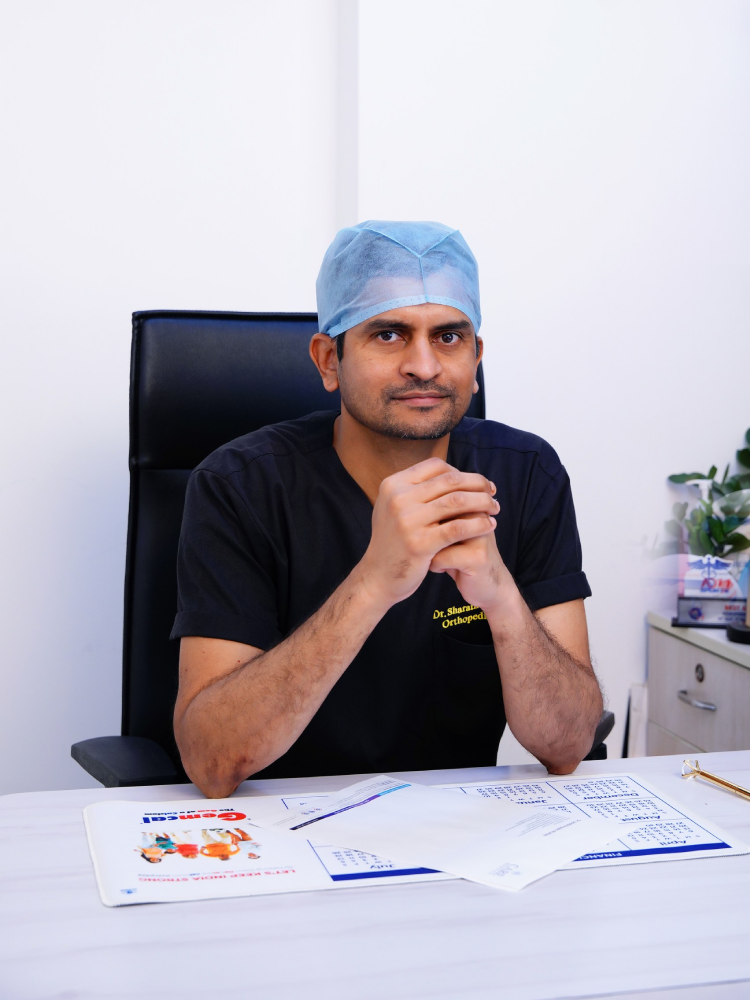
Best Joint Replacement Surgery in Hyderabad
Are you looking for the best joint replacement surgery in Hyderabad? Look no further than Dr. Sharath Babu. Renowned for his expertise and precision, Dr. Sharath Babu is widely regarded as the top and best joint replacement surgeon in Hyderabad. With a commitment to personalized care and advanced surgical techniques, he ensures optimal outcomes for his patients. By entrusting your joint replacement surgery to Dr. Sharath Babu, you can rest assured that you are in the hands of a skilled professional who prioritizes patient well-being and delivers exceptional results in the field of orthopedics
Dr. Sharath Babu is a renowned and highly skilled orthopedic and arthroscopic surgeon in Hyderabad with an extensive background in treating patients with sports injuries, trauma, and accidents. His reputation has made him one of the leading names in the orthopedic community of Hyderabad. Dr. Sharath Babu is highly regarded for his ability to provide tailored treatment approaches that cater to the individual needs of each patient, reflecting his deep commitment to delivering personalized care.
What sets Dr. Sharath Babu apart is his precision and the utilization of advanced joint replacement and orthopedic surgical techniques. His expertise in performing joint replacement surgeries is widely recognized, and he is often lauded for his exceptional outcomes and patient satisfaction. With a focus on providing the best joint replacement surgery in Hyderabad, Dr. Sharath Babu has consistently demonstrated his dedication to staying at the forefront of orthopedic advancements and delivering optimal results for his patients.
Patients seeking specialized care for orthopedic conditions, particularly those requiring joint replacement surgery, can trust in Dr. Sharath Babu's proficiency, experience, and commitment to excellence in providing the highest standard of care.
What is Joint Replacement Surgery?
Joint replacement surgery is a procedure performed on patients suffering from chronic joint pain or immobility. An accident or trauma or a degenerative bone disease like arthritis can cause damage to the joint and limit its functionality. Usually, the doctor tries to fix the joint with the help of conservative techniques like medication and physical therapy. In cases where the patient does not benefit from them, a surgery is recommended. In patients suffering from persistent joint pain and limited range of motion, joint replacement surgery is the most effective treatment option that restores the joint functionality and allows them to lead a better-quality life.Thanks to improved medical technologies, now we have quicker and lesser invasive joint replacement surgeries that require shorter hospital stays and have faster recovery timelines.
Steps in Joint Replacement Surgery
Pre-Operative Evaluation: Before the surgery, the patient undergoes a comprehensive evaluation, including medical history review, physical examination, and tests to assess the joint condition and overall health.Anesthesia: The patient receives anesthesia to ensure comfort and pain control during the procedure. Options include general anesthesia, regional anesthesia, or a combination of both.
Incision: The surgeon makes an incision to access the joint, often following minimally invasive techniques to reduce trauma and promote faster recovery.
Joint Preparation: The damaged joint components are removed, and the bone surfaces are prepared to receive the artificial joint components. This may involve smoothing, reshaping, or repositioning the bone.
Implant Placement: The artificial joint components, made of metal, plastic, or ceramic, are securely placed into position, ensuring proper alignment and stability.
Closure: The incision is closed with sutures or staples, and a dressing is applied to the surgical site.
Post-Operative Care: The patient is monitored closely in the recovery area and may receive pain management, physical therapy, and guidance on mobility and rehabilitation exercises to support healing and recovery.
Follow-Up: Regular follow-up appointments are scheduled to monitor progress, assess healing, and address any concerns or complications that may arise post-surgery.
By following these steps meticulously, joint replacement surgery aims to alleviate pain, improve function, and enhance the quality of life for patients with severe joint conditions.
There are three types of joint replacement surgeries:
- 1. Total Joint Replacement Surgery
Total joint replacement surgery involves partial or complete removal of the damaged joint. It is then replaced with artificial implants or prostheses made of material like ceramic, titanium and oxinium. Total joint replacement is performed to repair knees, hips, or shoulder. . Arthritis and other degenerative diseases or damage to joints due to an accident necessitate a joint replacement surgery.
Total joint replacement surgery can take a few hours, depending on the complexities. The entire procedure is done at the hospital after the patient is admitted and sedated for the surgery. During the surgery, the first step is to make an incision on the site to be operated on, and the damaged cartilage and bone are removed from the area. The removed bone is then replaced with a prosthetic implant. The prosthetic implant mimics the functions of the original bone and restores the lost mobility and functions in the patient. -
2. Revision Joint Replacement Surgery
Revision Joint replacement surgery is performed when the attempt to fix a joint condition through a total joint replacement surgery has failed. Improper placement of the implant, infection or an injury at the site necessitates a revision joint replacement surgery. During the procedure the damaged part is repaired and based on the requirement, a new implant is placed. -
3. Joint Preservation Surgery
Joint preservation surgery is another type of joint replacement surgery performed on knees, shoulders, or hips. It is an elective surgery where the patient elects to undergo a surgical procedure to protect the joints from further degeneration and delay the need for a total joint replacement surgery. Usually, youngsters with degenerative diseases opt for this procedure.
Joint pain, especially the chronic ones, is relayed by damaged caused to the articular cartilage present at the end of the bones. If you are experiencing constant pain and discomfort that is not getting better with other associated treatments, and diagnosed with a degenerative joint disease, your doctor might recommend you to go through a joint preservation surgery to restore the functionality of the joint.
However, before recommending this surgery, the surgeon will prescribe medication, steroid injections, physical therapy, and activity modifications to see if the condition can be fixed without a surgery.
Are you looking for the best joint replacement surgery in Hyderabad? Look no further than Dr. Sharath Babu. Renowned for his expertise and precision, Dr. Sharath Babu is widely regarded as the top and best joint replacement surgeon in Hyderabad. With a commitment to personalized care and advanced surgical techniques, he ensures optimal outcomes for his patients. By entrusting your joint replacement surgery to Dr. Sharath Babu, you can rest assured that you are in the hands of a skilled professional who prioritizes patient well-being and delivers exceptional results in the field of orthopedics.
Risks of Joint Replacement Surgery
- Infection
- Blood clots
- Nerve injury
- Prosthesis problems
Frequently Asked Questions
It is a long established fact that a reader will be distracted by the readable content of a page when looking at its layout.
The most common joint replacement surgery is knee replacement, with over 700,000 knees replaced annually, making it one of the most prevalent types of orthopedic surgeries.
The recovery time from joint replacement surgery varies depending on the individual, the type of surgery, and overall health. Generally, patients can expect a recovery period of several weeks to a few months, during which physical therapy and rehabilitation play a crucial role in restoring mobility and function.
Joint replacement surgery can cause discomfort and pain during the initial recovery period, which can be managed with pain medication prescribed by the healthcare provider. The level of pain experienced can differ among individuals based on factors like pain tolerance and the extent of the surgery.
While joint replacement surgery is generally considered safe and effective, like any surgical procedure, it carries some risks. Common complications that may arise from joint replacement surgery include infection, blood clots, and nerve issues, Prosthesis problems, but most complications can be treated successfully with proper medical care. Always ensure that you consult with your best orthopedic surgeon in Hyderabad about any negative issues you might feel after the surgery and get immediate help.

